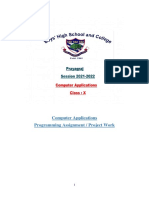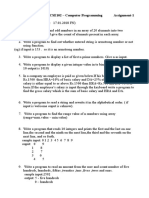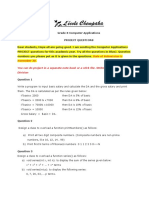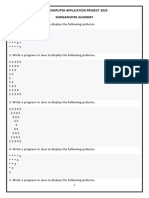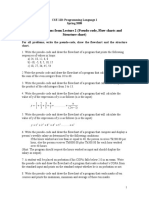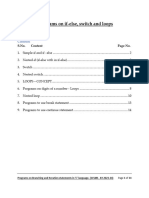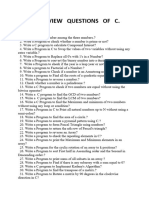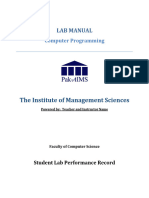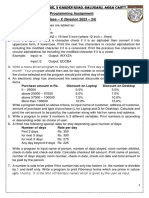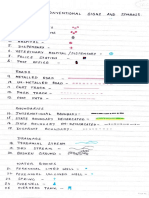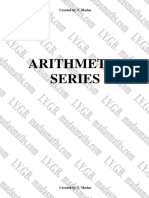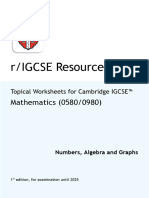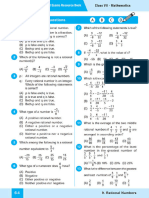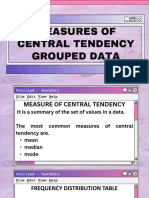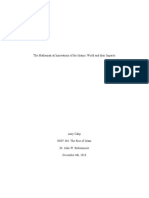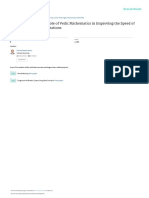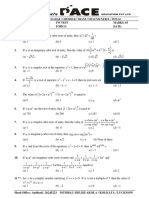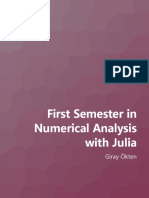0 ratings0% found this document useful (0 votes)
32 viewsComputer Project-2
Computer Project-2
Uploaded by
Samrat BanerjeeThe document contains 25 questions related to writing programs in Java to perform various mathematical and logical operations. The questions include writing programs to:
1) Calculate the perimeter and area of a triangle given its three sides.
2) Check if a number is a "sunny number" using the ternary operator.
3) Check if a number is prime.
4) Check if a number is a palindrome.
5) Calculate the grade based on marks in English.
Copyright:
© All Rights Reserved
Available Formats
Download as DOCX, PDF, TXT or read online from Scribd
Computer Project-2
Computer Project-2
Uploaded by
Samrat Banerjee0 ratings0% found this document useful (0 votes)
32 views6 pagesThe document contains 25 questions related to writing programs in Java to perform various mathematical and logical operations. The questions include writing programs to:
1) Calculate the perimeter and area of a triangle given its three sides.
2) Check if a number is a "sunny number" using the ternary operator.
3) Check if a number is prime.
4) Check if a number is a palindrome.
5) Calculate the grade based on marks in English.
Copyright
© © All Rights Reserved
Available Formats
DOCX, PDF, TXT or read online from Scribd
Share this document
Did you find this document useful?
Is this content inappropriate?
The document contains 25 questions related to writing programs in Java to perform various mathematical and logical operations. The questions include writing programs to:
1) Calculate the perimeter and area of a triangle given its three sides.
2) Check if a number is a "sunny number" using the ternary operator.
3) Check if a number is prime.
4) Check if a number is a palindrome.
5) Calculate the grade based on marks in English.
Copyright:
© All Rights Reserved
Available Formats
Download as DOCX, PDF, TXT or read online from Scribd
Download as docx, pdf, or txt
0 ratings0% found this document useful (0 votes)
32 views6 pagesComputer Project-2
Computer Project-2
Uploaded by
Samrat BanerjeeThe document contains 25 questions related to writing programs in Java to perform various mathematical and logical operations. The questions include writing programs to:
1) Calculate the perimeter and area of a triangle given its three sides.
2) Check if a number is a "sunny number" using the ternary operator.
3) Check if a number is prime.
4) Check if a number is a palindrome.
5) Calculate the grade based on marks in English.
Copyright:
© All Rights Reserved
Available Formats
Download as DOCX, PDF, TXT or read online from Scribd
Download as docx, pdf, or txt
You are on page 1of 6
0Project – 2 (Computer Applications)
Questions
1. Write a program to input 3 sides of a triangle
and find the perimeter and area of the triangle.
If a, b, and c are the 3 sides then,
Perimeter = a+ b+c
a+b+ c
Area = √ s ( s−a )( s−b ) ( s−c ) where s = 2
2. A number n is said to be a sunny number if, √ n+1 is
equal to an integer. For example, 8 is sunny as
√ 8+1 = 3 which is an integer. Write a program to
input a number and using the ternary operator
check whether it is a sunny number or not.
3. Write a program to accept a number. Check and
print whether it is a prime number or not.
A prime number is a number which is divisible by
1 and itself only. For example, 2, 3, 5, 7, 11, 13
are all prime numbers.
4. Write a program to accept a number from the
user and check whether it is a palindrome
number or not. A number is a palindrome which
when reads in reverse order is same as in the
right order. For example, 242 is a palindrome
number.
5. Write a program to input the marks in English
and find the grade obtained, depending upon the
following criteria:
Marks in English Grade
90 and above A
70 to 89 B
50 to 69 C
35 to 49 D
Below 35 E
6. A cloth showroom has announced the following
festival discounts on the purchase of items,
based on the total cost of the items purchased:
Total cost Discount (in
Percentage)
Less than Rs.2000 5%
Rs.2001 to Rs.5000 25%
Rs.5001 to Rs.10000 35%
Rs.10000 and above 50%
7. Pg.159 Q14
8. Pg.166 Q17
9. A prime number is said to be 'Twisted Prime', if
the new number obtained after reversing the
digits is also a prime number. Write a program to
accept a number and check whether the number
is 'Twisted Prime' or not. For example, 167 is
‘Twisted Prime’ because 761 is a prime no.
10. A Dudeney number is a positive integer that
is a perfect cube such that the sum of its digits
is equal to the cube root of the number. Write a
program to input a number and check and print
whether it is a Dudeney number or not. For
example, 512 is a Dudeney number as sum of
digits of 512 = 8 and cube root of 512 = 8.
11. Write a program to enter two numbers and
check whether they are co-prime or not. Two
numbers are said to be co-prime, if their HCF is
1. For example, 14, 15 are co-prime.
12. Write a program to accept a number and
check whether it is a 'Spy Number' or not. A
number is spy if the sum of its digits equals the
product of its digits. For example, 1124 is a spy
number as sum of the digits = 8 and product of
the digits = 8
13. Write a program in Java to find the sum of
the given series:
S = a + a2 / 2 + a3 / 3 + …… + a10 / 10
14. Pg.203 Q23
15. Pg.204 Q26
16. Using switch statement, write a menu driven
program for the following:
(a) To find and display the sum of the series
given below:
S = x1 - x2 + x3 - x4 + x5 - ………… - x20; where x = 2
(b) To display the series:
1, 12, 123, 1234, 12345
For an incorrect option, an appropriate error
message should be displayed.
17. Write a program in Java to input the values
of x and n and print the sum of the following
series:
S = 1 + (x+2)/2! + (2x+3)/3! + (3x+4)/4! + ……… to
n terms
18. Write a program to compute and display the
sum of the following series:
S = (1 + 2) / (1 * 2) + (1 + 2 + 3) / (1 * 2 * 3) +
-------- + (1 + 2 + 3 + ----- + n) / (1 * 2 * 3 * -----
* n)
19. Write a program to print the series:
0, 3, 8, 15, 24, ………… to n terms. (Value of 'n' is
to be an input by the user)
20. Write a program in Java to find the sum of
the following series:
S = a - (a/2!) + (a/3!) - (a/4!) + ……. to n
21. Pg.205 Q42
22. Write a program in Java to display the
following pattern:
54321
4321
321
21
1
23. Write a program to input a number. Check
and display whether it is a Niven number or not.
A number is said to be Niven which is divisible by
the sum of its digits. For example, 126 is a Niven
number as sum of its digits = 9 and 126 is
divisible by 9.
24. Pg.168 Q22
25. Write a program to compute and display the
sum of the following series:
S = (1 + 2) / (1 * 2) + (1 + 2 + 3) / (1 * 2 * 3) +
-------- + (1 + 2 + 3 + ----- + n) / (1 * 2 * 3 * -----
* n)
SEE EDGE COLLECTIONS FOR QUESTIONS
You might also like
- New Enjoying Mathematics Class 8 - Chapter 1Document25 pagesNew Enjoying Mathematics Class 8 - Chapter 1Samson Samuel50% (4)
- Math 3 Demo Lesson Plan - Exponential NotationDocument6 pagesMath 3 Demo Lesson Plan - Exponential NotationMaria Mercy Dela RosaNo ratings yet
- DAX Cheat SheetDocument12 pagesDAX Cheat SheetRaviNo ratings yet
- 2100 (Aug15) Tutorials - Complete SetDocument16 pages2100 (Aug15) Tutorials - Complete SetLim Weng SeongNo ratings yet
- X Computer Applications23-24Document5 pagesX Computer Applications23-24btpirtaza123No ratings yet
- Que 1Document76 pagesQue 1Anushka JoshiNo ratings yet
- Cisce - Grade 10 - Project Questions 24-25Document4 pagesCisce - Grade 10 - Project Questions 24-25aminarisha1No ratings yet
- Computer Applications Programming Assignment / Project WorkDocument10 pagesComputer Applications Programming Assignment / Project WorkRuchi PandeyNo ratings yet
- List of C - ProgramsDocument10 pagesList of C - ProgramsMohammed SufiyanNo ratings yet
- All Program of Class 12 IscDocument25 pagesAll Program of Class 12 IscSLG. STATUS LOVERS GROUP100% (1)
- Std10 Computer Project 23 24Document7 pagesStd10 Computer Project 23 24abhinavdby1008No ratings yet
- Lab Report 1Document2 pagesLab Report 1mahedi.hassanNo ratings yet
- C AssignmentDocument11 pagesC AssignmentKeshavNo ratings yet
- ECE-C CSE102 - Computer Programming Assignment-1Document3 pagesECE-C CSE102 - Computer Programming Assignment-1sajithNo ratings yet
- Class IX 2022 (Program&Projects)Document2 pagesClass IX 2022 (Program&Projects)KomaliNo ratings yet
- BlankDocument50 pagesBlankVanshika LalwaniNo ratings yet
- Cpu SetDocument10 pagesCpu Setsaifz2010No ratings yet
- Java Assignments To Be Completed For Icse 2015 Practical FileDocument9 pagesJava Assignments To Be Completed For Icse 2015 Practical FilemeensharNo ratings yet
- 26 Loop ProblemsDocument4 pages26 Loop ProblemsAbdul MunimNo ratings yet
- Practice QuestionsDocument5 pagesPractice Questionsvarsha guptaNo ratings yet
- Ode Antra: C - Language Assignment SheetDocument11 pagesOde Antra: C - Language Assignment SheetJuni IndoreNo ratings yet
- C Lab 1Document3 pagesC Lab 1bishwash neupaneNo ratings yet
- Basic Expression and Arithmetic Operation Program Lab-1Document10 pagesBasic Expression and Arithmetic Operation Program Lab-1parshwazavariNo ratings yet
- Python Programming To Solve Scientific Problems Using Iterative LoopsDocument6 pagesPython Programming To Solve Scientific Problems Using Iterative LoopsKarunambika ArumugamNo ratings yet
- C Programming Lab ManualDocument8 pagesC Programming Lab Manualnalluri_08No ratings yet
- ASSIGNMENTS (GR X)Document4 pagesASSIGNMENTS (GR X)Vrushank MoreNo ratings yet
- Special PracticalsDocument3 pagesSpecial PracticalsNkuin MbengNo ratings yet
- Sample Practical FileDocument10 pagesSample Practical FileDev TinkerNo ratings yet
- Codelist 150517162428 Lva1 App6892Document11 pagesCodelist 150517162428 Lva1 App6892ahmedNo ratings yet
- Updated Project WorkDocument6 pagesUpdated Project Workgarof nabajinNo ratings yet
- Screenshot 2023-09-20 at 3.12.53 PMDocument9 pagesScreenshot 2023-09-20 at 3.12.53 PMjindalipad10No ratings yet
- Icse Computer Application Project 2025Document5 pagesIcse Computer Application Project 2025Zafeerul RrayyanNo ratings yet
- CPMDocument19 pagesCPMjubecseNo ratings yet
- Sample Project File - XDocument40 pagesSample Project File - XHemu MaximumNo ratings yet
- C Programming PracticeDocument3 pagesC Programming PracticetartotuspuNo ratings yet
- Praclist Xi Python19-20Document9 pagesPraclist Xi Python19-20Uditanshu PandeyNo ratings yet
- Pds Lab 2022A Question Paper Upto A03Document5 pagesPds Lab 2022A Question Paper Upto A03Hitesh DaburNo ratings yet
- Practice Problems 01 Pseudocodes and FlowchartsDocument3 pagesPractice Problems 01 Pseudocodes and FlowchartsJahidul HasanNo ratings yet
- C-Lang Programss List - If, Switch, Loops, Break and ContinueDocument14 pagesC-Lang Programss List - If, Switch, Loops, Break and Continuerakeshbairi2005No ratings yet
- Computer Applications Project-Class X SESSION 2021-22Document9 pagesComputer Applications Project-Class X SESSION 2021-22Aratrika ChakravartyNo ratings yet
- Python QBDocument8 pagesPython QBSameer NajamNo ratings yet
- C Programming Beginners QuestionsDocument12 pagesC Programming Beginners QuestionsMuraliShiva0% (1)
- Coding Based QuestionDocument6 pagesCoding Based QuestionRam BhardwajNo ratings yet
- FOP Assignment-I August 2018Document4 pagesFOP Assignment-I August 2018johnnymontgomery69No ratings yet
- Project20question2024Document2 pagesProject20question20244104animesh1729No ratings yet
- Assignment #4v PFDocument6 pagesAssignment #4v PFhabiti747No ratings yet
- Work Sheet 3 - Repetition Flow Controls 60070Document13 pagesWork Sheet 3 - Repetition Flow Controls 60070Fares BelaynehNo ratings yet
- Practice ProgramsDocument8 pagesPractice Programsyerrakulathanmayi2004No ratings yet
- Practical - Tutorial 4 - 3Document5 pagesPractical - Tutorial 4 - 3Sébastien FortunoNo ratings yet
- C Programs ListDocument18 pagesC Programs ListSahil AntwalNo ratings yet
- Class X Record Book QuestionsDocument5 pagesClass X Record Book Questionsbanani.globalNo ratings yet
- CLASS 9 Computer Apps Project AssignmentDocument6 pagesCLASS 9 Computer Apps Project AssignmentCOOL GAMER SHIWANGNo ratings yet
- Computer Application Project For Class X (2010-21) : (Mid Term)Document10 pagesComputer Application Project For Class X (2010-21) : (Mid Term)vimala murgeshNo ratings yet
- Lab 2 (Conditional Statements)Document3 pagesLab 2 (Conditional Statements)DigiModNo ratings yet
- C ProblemsDocument9 pagesC ProblemsggyuuouNo ratings yet
- Lab Evaluation 3 Question Sets PDFDocument12 pagesLab Evaluation 3 Question Sets PDFnirmalNo ratings yet
- CP Lab ManualDocument15 pagesCP Lab ManualRaees KhanNo ratings yet
- C Lab SheetDocument4 pagesC Lab SheetRamesh ShresthaNo ratings yet
- Computer Holiday Homework Class 10 ICSE 2023 - 24Document4 pagesComputer Holiday Homework Class 10 ICSE 2023 - 24꧁KAIF꧂ Ali KhanNo ratings yet
- Class X Computer ProjectDocument5 pagesClass X Computer ProjectManpreet KaurNo ratings yet
- Geography Project DraftDocument13 pagesGeography Project DraftSamrat BanerjeeNo ratings yet
- Literature Project DraftDocument4 pagesLiterature Project DraftSamrat BanerjeeNo ratings yet
- Chemistry Project DraftDocument9 pagesChemistry Project DraftSamrat BanerjeeNo ratings yet
- History Project DraftDocument13 pagesHistory Project DraftSamrat BanerjeeNo ratings yet
- 3 Working Methods To Install Windows 11 On Unsupported PCsDocument11 pages3 Working Methods To Install Windows 11 On Unsupported PCsSamrat BanerjeeNo ratings yet
- Grography PresentationDocument8 pagesGrography PresentationSamrat BanerjeeNo ratings yet
- Literature Project-2Document11 pagesLiterature Project-2Samrat BanerjeeNo ratings yet
- Convectional Signs and SymbolsDocument2 pagesConvectional Signs and SymbolsSamrat BanerjeeNo ratings yet
- Arithmetic - Series Exam - QuestionsDocument91 pagesArithmetic - Series Exam - Questionsyvonne nolaNo ratings yet
- Numbers, Algebra and GraphsDocument18 pagesNumbers, Algebra and Graphspillboxsesame0sNo ratings yet
- NKANDE PLC GRADE 7 TERM-4 P1 MATHEMATICS_241014_203039Document8 pagesNKANDE PLC GRADE 7 TERM-4 P1 MATHEMATICS_241014_203039MbongeniNo ratings yet
- Module 2 Eed 2Document32 pagesModule 2 Eed 2Laika EnriquezNo ratings yet
- CL 7 - 9. Rational NumbersDocument3 pagesCL 7 - 9. Rational NumbersKusuma HaranathNo ratings yet
- Tips Tricks and Formulae On Ratio and ProportionDocument6 pagesTips Tricks and Formulae On Ratio and ProportionmsmgectNo ratings yet
- Factorisation ProblemsDocument1 pageFactorisation Problemsproodoot100% (1)
- Assignment 01 SolutionDocument6 pagesAssignment 01 SolutioncontactghezleneNo ratings yet
- MCT Grouped DataDocument19 pagesMCT Grouped DataJames AllasNo ratings yet
- The Mathematical Innovations of The Islamic World PDFDocument16 pagesThe Mathematical Innovations of The Islamic World PDFAngelica Mercy CalipNo ratings yet
- Mastering The Art of Addition and Subtraction in Fractions and Mixed NumbersDocument14 pagesMastering The Art of Addition and Subtraction in Fractions and Mixed NumbersMichelle SantosNo ratings yet
- Vedic MathsDocument12 pagesVedic MathsJahazel RomuloNo ratings yet
- Complex NumberDocument3 pagesComplex NumberSaishaNo ratings yet
- Unit 5 - Basic Electrical and Electronics Engineering - WWW - Rgpvnotes.inDocument39 pagesUnit 5 - Basic Electrical and Electronics Engineering - WWW - Rgpvnotes.inpandeypraj165No ratings yet
- Budget of Work: Mathematics 2Document3 pagesBudget of Work: Mathematics 2iceberghoneyNo ratings yet
- AT 9e ISM 00Document47 pagesAT 9e ISM 00JORGE ESTUARDO MO AYALANo ratings yet
- Chapter One: Objectives Binary, Octal, Hexadecimal and BCD Number System. Number ConversionDocument8 pagesChapter One: Objectives Binary, Octal, Hexadecimal and BCD Number System. Number ConversionWazazzu WazazzuNo ratings yet
- ZGJKH SXD Y3 Arc ZYWVNusDocument48 pagesZGJKH SXD Y3 Arc ZYWVNusTanvi Tamanna Tamanna DashNo ratings yet
- Central LocationDocument19 pagesCentral LocationRejane Mae TapungotNo ratings yet
- Math Assignment Real NumbersDocument3 pagesMath Assignment Real NumbersAnonymous CFKihAgzq100% (1)
- Writing A C Compiler, Part 2Document5 pagesWriting A C Compiler, Part 2tuan.ebook3No ratings yet
- 1078 Basic Algebra Questions: Factoring, Expanding, and SimplifyingDocument18 pages1078 Basic Algebra Questions: Factoring, Expanding, and SimplifyingRonaldo ManaoatNo ratings yet
- Numerical Análisis With JuliaDocument215 pagesNumerical Análisis With JuliaBoris100% (3)
- DE Unit 2Document79 pagesDE Unit 2Doctor StarkNo ratings yet
- GenMath Module 3 Week 3Document16 pagesGenMath Module 3 Week 3Immanuel Cañeca100% (1)
- Worksheets For Computer Science Orientation: Daniel BallsDocument68 pagesWorksheets For Computer Science Orientation: Daniel Ballsxiaxia xxiNo ratings yet
- Big Bay Bei Final Round 2021 P6Document15 pagesBig Bay Bei Final Round 2021 P6thanthtoolwin29No ratings yet







